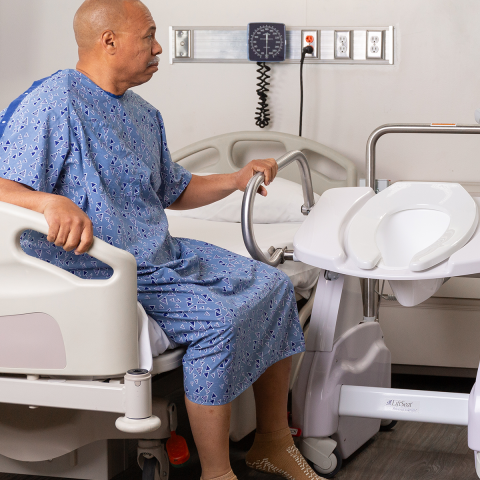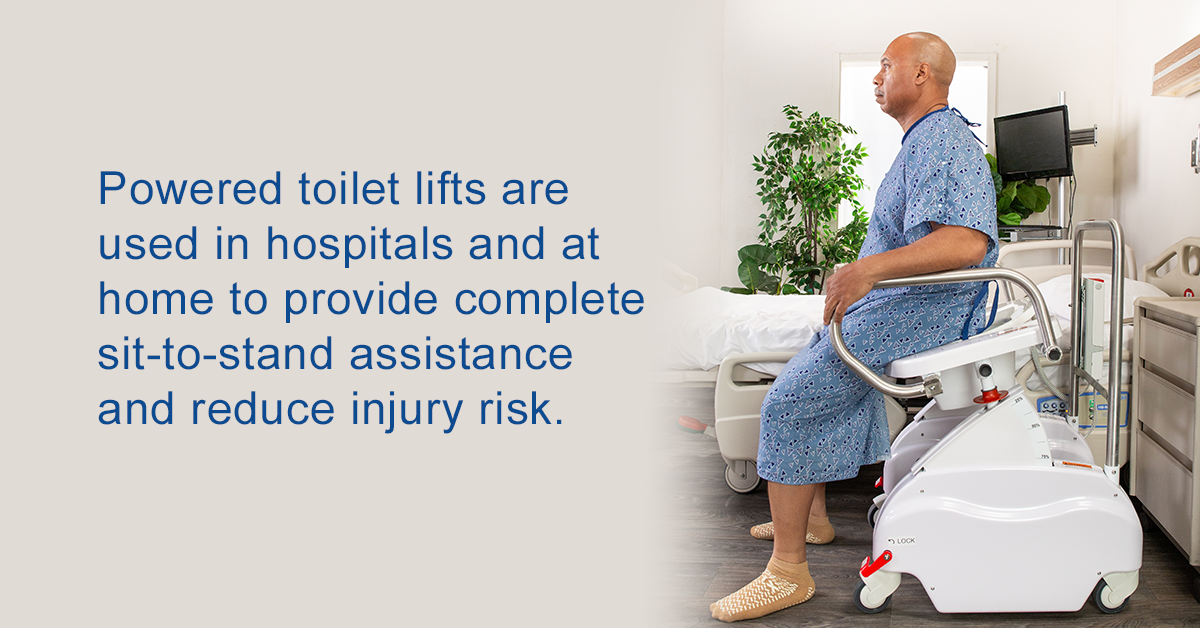The Evolution of Medical Lift Technology: From Manual to Power-Assisted
06/21/2024
Lifting someone is no easy task – especially without assistance. For most of human history, the only way to move someone was to lift them manually. Manual lifting requires a great deal of strength and, without proper technique, can injure both caregiver and recipient.
Over the centuries, advancements in lifting technology have been made to assist caregivers in safer lifting and allow care recipients greater independence of movement. From full-body patient lifts to power toilet lifts, many types of advanced lifting assistance are available today.
Hospital Beds
Until the mid-twentieth century, hospital beds weren’t very different from standard beds, so any patient lifting or repositioning had to be performed manually.
In 1909, Dr. Willis D. Gatch recognized a need for built-in repositioning capabilities and invented the first adjustable hospital bed.1 Commonly referred to as the “Gatch bed” (even to this day), the initial model was operated using a manual crank to raise and lower the head and foot of the bed as needed.
While manual crank hospital beds are still sold today, many are now power-assisted for ease of use and come with an array of additional capabilities. Some of the more advanced models can transform into a fully seated position or measure a patient’s weight, minimizing the amount of patient movement and, therefore, lifting that nursing staff need to perform.
Full Body Patient Lifts
Full-body patient lifts are a familiar tool in modern rehabilitation and hospital facilities. There are two main types: mobile and ceiling or wall-mounted. The mobile lifts are often called “Hoyer Lifts,” taking their name from Ted Hoyer (a quadriplegic), who developed the first mobile patient lift along with Victor R Hildemann to help him gain greater mobility. Their device was patented in 1958, over 3 years after the initial filing.2
Early lift versions used a hand pump mechanism to lift the patient. Many models today employ this same manual pumping mechanism, while others, called “power” or “electric lifts,” offer motorized assistance for easier use.
Toilet Lifts
Toilets, as we know them today, are a relatively new invention. For thousands of years, toilets were little more than a platform with an opening that led to a hole in the ground or emptied into a sewer below.3 The invention and eventual widespread adoption of the flushing toilet that accompanied “the Industrial Revolution’s improvements in manufacturing and waste disposal” marked a large step forward in toilet technology.4
The advent of accessible toilet design, at least on a larger scale, is even more recent. An Architect named Selwyn Goldsmith was an outspoken proponent of accessible design and published a book in 1967 called Designing for the Disabled. In the book, Goldsmith recommends design modifications in many areas of the home and public spaces, including restrooms. In a book review, Professor Elizabeth Guffey of the State University of New York explains, “The text's exhaustive technical detail is what won Goldsmith's text its status as a classic and explains why it still can be found in libraries today. Its seemingly dispassionate diagrams make clear that much of what passes for disability can actually be fixed by relatively easy to implement and thoughtful design, including constructing ramps, expanding door widths, and building lavatories with higher toilet seats, more accessible flushing handles, and support rails on either side of the toilet.”5
To this day, elevated toilet seats are a common solution for individuals who have difficulty standing up from a toilet. “Toilet risers” or “toilet seat risers” can be easily purchased through many in-store and online retailers. However, these types of toileting aids don’t work well for many individuals, including those with significant lower or upper body weakness.
Power toilet lifts, which use an electric motor to gently raise and lower users onto and up from the toilet, are a more advanced option suitable for individuals needing the most significant level of support. First developed for use in hospital settings, they are now available for home use too.
LiftSeat Power Toilet Lifts have continued to advance this technology, adding a bidet option to provide hands-free cleaning. They also offer many modification options, from seat height and tilt to retractable handles for easy side transfers. LiftSeat has also expanded its offerings to include an all-purpose lifting chair, designed to give users the mobility to interact in many previously inaccessible environments.

Stair Lifts
The first recorded use of a stair lift (also written as stairlift) is rumored to be attributed to Henry VIII, who due to injury and obesity, had difficulty climbing the stairs. Dubbed the “stairthrone”, this rudimentary stair lift is thought to have been operated using a “block and tackle system similar to those used on the king's warship the Mary Rose…with servants pulling on ropes to lift the monarch's body”6.
In 1923, a Cadillac dealership owner named C.C. Crispen developed a more refined chair lift after visiting a neighbor who could not use the stairs due to illness.7 This lift style is still used today to help individuals with limited mobility bypass the stairs without obstructing them.
Rising to the Occasion
Medical lift technology has advanced significantly in the last century. Today’s caregivers, both professional and informal, have many tools available to make lifting easier, whether in the hospital or at home. With research highlighting the benefits of assisted lifting devices in injury prevention and continued focus on safe patient handling programs, this technology will undoubtedly continue to grow in popularity over the coming years.
References:
- Indiana University School of Medicine. (n.d.). Founding and Early History. Indiana University School of Medicine. https://medicine.iu.edu/about/history
- Hoyer, T. R., & Hildemann, V. R. (1958, January 28). Adjustable base invalid lift.
- Wald, C. (2016). The Secret History of Ancient Toilets. Nature, 533(7604), 456–458. https://doi.org/10.1038/533456a
- Barksdale, N. (2015, May 19). Who Invented the Flush Toilet? History.com. https://www.history.com/news/who-invented-the-flush-toilet
- Guffey, E. (2020). Selwyn Goldsmith’s designing for the disabled, 2nd ed. (1967): Flawed, dated, and disavowed, yet a classic with enduring value. She Ji: The Journal of Design, Economics, and Innovation, 6(4), 439–454. https://doi.org/10.1016/j.sheji.2020.04.002
- Henry VIII used his very own “stairthrone” when the steps became too much, says Starkey. (2009, February 6). DailyMail.Com. Retrieved June 20, 2024, from https://www.dailymail.co.uk/news/article-1138522/Henry-VIII-used-stairthrone-steps-says-Starkey.html
- Our History. Inclinator Company of America. (2023, November 28). https://inclinator.com/history/
This content is not intended to be a substitute for professional medical advice, diagnosis, or treatment. Always seek the advice of your physician or other qualified health provider with any questions you may have regarding a medical condition.